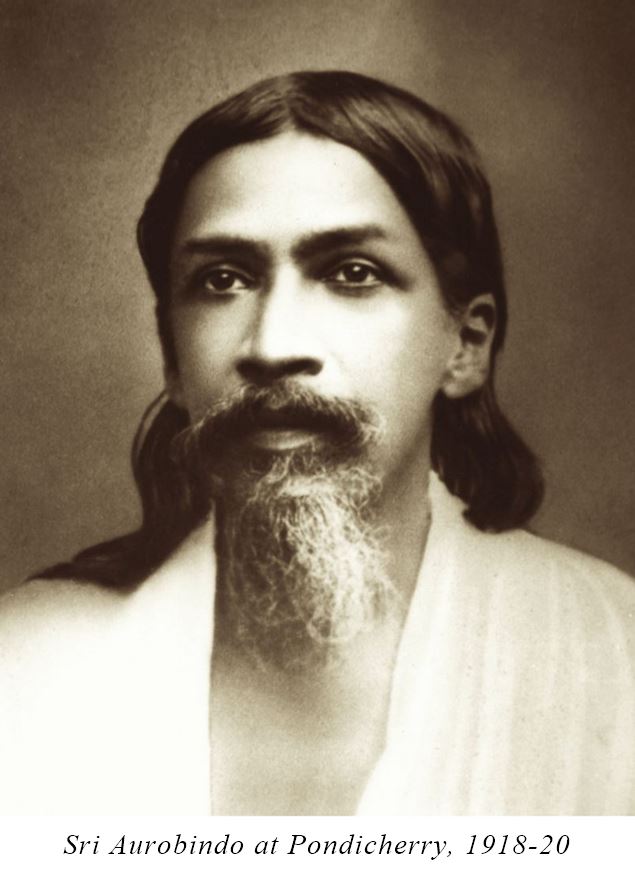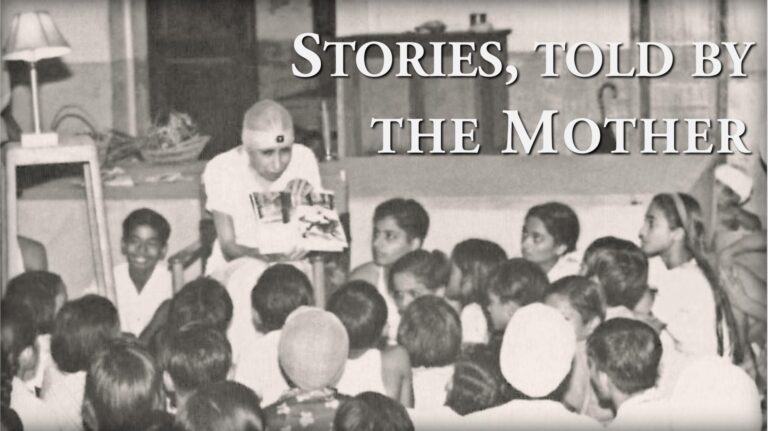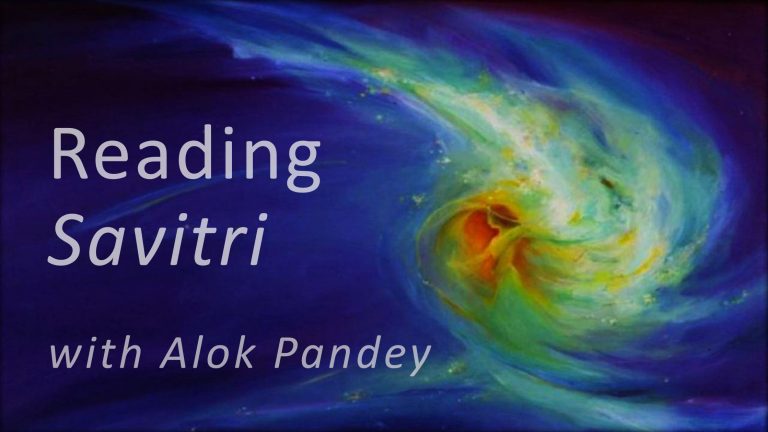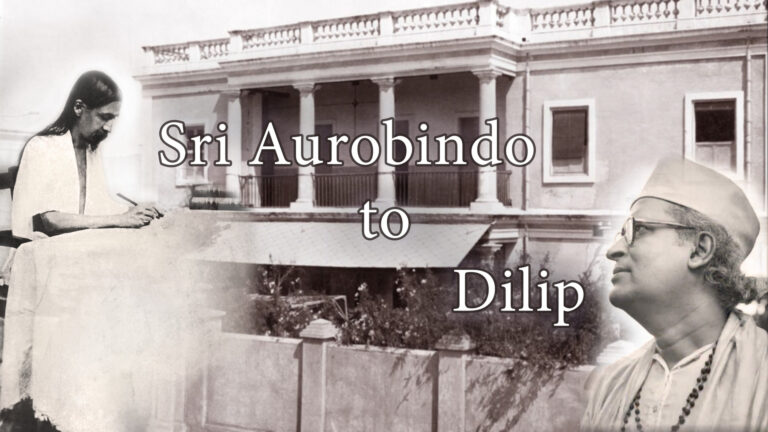“The illumined seer and priest of the call, free from harms, shining with light, carrying his banner of smoke, him we seek, the ray of intuition of the sacrifices.”
Rig Veda: 8.44.10
On the 4th of April, 1910, Sri Aurobindo arrived by the steamer Dupleix at Pondicherry with Bejoy Nag at about 4 in the afternoon. Moni (Suresh Chakravarty) had already arrived on the 31st March and put up at the house of Srinivasachari, an orthodox Tamil Brahmin, to whom he had brought a letter of introduction from Sri Aurobindo. Srinivasachari had at first taken Moni for a spy, and did not attach any importance to his request for finding a suitable house for Sri Aurobindo. But when Moni announced the date of Sri Aurobindo’s arrival, Srinivas took him at his word and thought of arranging a public reception. But Moni dissuaded him, saying that Sri Aurobindo’s coming to Pondicherry was a closely guarded secret and that he would like to live in strict solitude in order to avoid harassment by the agents of the British Government. So, the idea of a public reception was abandoned, and only Moni and Srinivasachari went to the port to receive Sri Aurobindo.[1]
Sri Aurobindo, Bejoy and Moni were lodged on the second floor of Shankar Chetty’s house in Comoutty Street. They stayed there till October. It was the same house where Swami Vivekananda had stayed when he had visited Pondicherry, sometime ago. As there was no bathroom in his apartment, Sri Aurobindo had to come down to the ground floor every day for his bath. They stayed there for about six months as Shankar Chetty’s guests. It was a completely secluded life; and, though the agents of the British Government must have been about, prowling and prying, they could discover no clue to their whereabouts. During the first three months, Bejoy and Moni had to keep to their room day and night. Afterwards Sri Aurobindo allowed them to go out. As a rule, visitors were not admitted, unless somebody wanted to see Sri Aurobindo on a special purpose and was fortunate enough to receive his permission.
Motilal Roy of Chandernagore sent to enquire about Sri Aurobindo’s safe arrival. Subramania Bharati, the renowned poet, patriot and national worker of South India, who had been living at Pondicherry as a political refugee from British India, came in close touch with Sri Aurobindo and used to visit him very often with Srinivasachari. Later, he would see him every day in the evening. He was profoundly influenced by Sri Aurobindo. Writing about the year 1913 in his reminiscences, “Old Long Since”, Amrita says, “Every evening, a little after dark, Bharati would go to Sri Aurobindo’s house. He chose that time not with the purpose of avoiding people who would want to make a note of his visit. It was because Sri Aurobindo used to come out of his room and receive his friends only after seven in the evening. An exception, however, was made for close friends like Bharati and Srinivasachari, who, at a very urgent need, could see him at any time of the day. Their visits to Sri Aurobindo’s house after seven had become a regular affair. Bharati would visit without fail; it was not so with Srinivasachari however.
“There was hardly any subject which they did not talk about in their meetings at night. They discussed literature, society, politics, the various arts….”[2] Long afterwards “Bharati learnt the Rig Veda from Sri Aurobindo”.
About a week after Sri Aurobindo was lodged at Shankar Chetty’s house, a distinguished French thinker and scholar, Paul Richard, came to Pondicherry in connection with Mon. Paul Blusion’s election to the French Chamber. Though the ostensible reason for his coming was the election, he had something much more important up his sleeve. “He was sent from France by Mira — she whom we know as the Mother.”[3] She had given him the sketch of a Yogachakra (a mystic symbol) saying that its interpreter was to be found in India and that he who would interpret it was her master and guide in yoga. On landing at Pondicherry, Paul Richard enquired whether there was any Yogi in the town. He was told of Sri Aurobindo, and as an interview was not an easy affair, he took the help of his friend, Zir Naidu, who was a prominent leader in politics, and obtained Sri Aurobindo’s permission. He saw Sri Aurobindo twice and had long talks with him, and he also got from him the interpretation of the mystic symbol. He was so much impressed by Sri Aurobindo that he hailed him afterwards as the greatest of the Sons of Heaven living upon earth, “the leader, the hero of tomorrow”.[4]
It was while he was staying in Shankar Chetty’s house that Sri Aurobindo fasted for about 23 days, just as an experiment. Asked about it later, he said, “when I did my fast of about 23 days in Chetty’s house, I very nearly solved the problem (of doing without food). I could walk eight hours a day[5] as usual. I continued my mental work and sadhana as usual and I found that I was not in the least weak at the end of 23 days. But the flesh began to grow less and I did not find a clue to replacing the very matter reduced in the body.
“When I broke the fast, I did not observe the common rule of people who undergo long fasts, — beginning with a little food, and so on. I began with the same quantity as I used to take before.”[6]
On the question of fasting, Sri Aurobindo said again afterwards: “I fasted twice: once in Alipore (jail) for ten days, and another time in Pondicherry for 23 days. At Alipore I was full of Yogic activities, I was not taking my food and was throwing it away into the bucket; of course, the Superintendent did not know of it, only two warders knew about it and they informed others saying: ‘This gentleman must be ill; he will not live long!’ Though my physical strength was diminishing, I was able to raise a pail of water above my head which I could not do ordinarily.
“At Pondicherry, while fasting, I was in full mental and vital vigour. I was even walking eight hours a day and not feeling tired at all. And when I broke the fast I did not begin slowly but with the usual normal amount of food.”
When some one asked him, “How is such fasting possible”, he said, “One draws energy from the vital plane instead of depending upon physical substance… ”[7]
K.V. Rangaswami, a zamindar of Kodailam, met Sri Aurobindo at Shankar Chetty’s house. He represented the landlords in the Legislative Assembly in Delhi during the British rule. His guru, Nagai Japata, who was a famous Yogi, had said to him at the time of his death that a great Yogi would come from the North (of India) of whose guidance he could avail himself in his absence. The Yogi, he said, would come to South India seeking refuge, and could be recognised by the triple declaration made by him before. When K.V. Rangaswami heard that Sri Aurobindo had come down to Pondicherry, he thought that it must be he whom his guru had referred to. So he came and saw Sri Aurobindo and promised to bear the cost of publishing the book, Yogic Sadhan.[8]

To quote Sri Aurobindo, “There was a famous Yogi in the South who, while dying, said to his disciples that a Purna Yogi from the North would come down to the South and he would be known by three sayings. These three sayings were the three things I wrote in a letter to my wife. A zamindar disciple of that Yogi found me out and bore the cost of the book Yogic Sadhan.” He also gave some money to Sri Aurobindo and pledged regular financial help. But his help ceased to be regular and finally stopped altogether. He visited Sri Aurobindo twice again at Pondicherry.
Ramaswamy Iyengar[9], later known as Va-Ra, came with K.V. Rangaswami. He was powerfully drawn to Sri Aurobindo and came to live with him for sometime in 1911. Sri Aurobindo had seen him in a vision before his coming. In one of his evening talks he said about this vision: “I myself have had these visions, only I don’t usually try to remember or verify them. But there were two curious instances which were among the first of this kind and which therefore I remember…. The other was a certain V. Ramaswamy whom I had to meet, but I saw him not as he was when he actually came, but as he became after a year’s residence in my house. He became the very image of the vision, a face close-cropped, rough, rude, energetic, the very opposite of the smoothfaced Vaishnava who came. So that was the vision of a man I had never seen but as he was to be in future — a prophetic vision.”[10]
Saurin, Sri Aurobindo’s brother-in-law (Mrinalini Devi’s cousin) came from Bengal by the end of September and stayed with Sri Aurobindo. In October — probably towards the end — Sri Aurobindo moved from Shankar Chetty’s house to Rue Suffren in the southern part of the town and lived there till April, 1911. Nolini Kanta Gupta came from Bengal and joined them in November, 1910. Except for a few short visits to Bengal, Nolini Kanta, Moni and Bejoy lived permanently with Sri Aurobindo as his disciples. Bejoy went back to Bengal sometime in the early thirties and died there soon after. Moni passed away at Pondicherry in 1951, and Nolini Kanta, a wiry young man of eighty, the only surviving member of the first batch, has been the Secretary of Sri Aurobindo Ashram ever since its foundation.
It is remarkable how Sri Aurobindo who, shy and reserved by temperament, lived in solitude and seclusion, fully absorbed in his supramental Yoga and the whirl and rush of its revolutionary developments, attracted to himself, one after another, so many of the souls who were touched by his light and were destined to be the standard-bearers of his epoch-making spiritual work. When the “Rose of God” blooms can the bees tarry to flock and forgather?
[1] According to A.B. Purani, Subramania Bharati also was with them but we have taken Moni’s version as being more authentic. In his Bengali book, Smritikatha, Moni has given a graphic description of how he and Srinivasachari received Sri Aurobindo on board the steamer, took tea with him at the cabin, and brought down his luggage etc.
[2] Old Long Since: by Amrita (Mother India: August 1962). Amrita, who was manager of Sri Aurobindo Ashram, came into contact with Sri Aurobindo as early as 1913, when he was a school boy.
[3] Old Long Since: Amrita (Mother India: January 1963).
[4] The Dawn Over Asia: Paul Richard.
[5] Italics are ours.
[6] A.B. Purani: Evening Talks, 2nd series.
[7] A.B. Purani: Evening Talks, 2nd series.
[8] For the first three months of their stay at Shankar Chetty’s house, they used to have Seances of an evening, in which automatic writing was done both as an experiment and an amusement. The book, Yogic Sadhan, was written during some of these Seances. Sri Aurobindo said in one of his evening talks, “When I was writing it, every time at the beginning and at the end the image of Ram Mohan Roy came before me”. The author’s name was printed in the book as Uttara Yogi. In 1927, Sri Aurobindo withdrew the book from circulation as it was not written by him.
[9] A friend of C.R. Das and a famous Tamil writer.
[10] A.B. Purani: Evening Talks.



